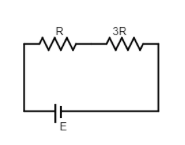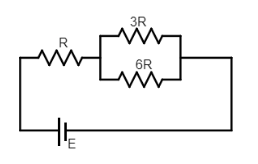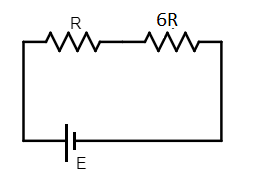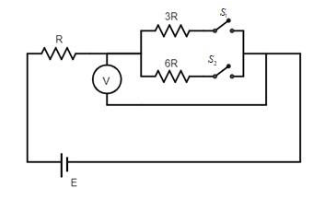Answer
414.6k+ views
Hint:In case of the closed circuit, we use Kirchhoff's voltage law to find the potential flowing through the given closed circuit.
Complete step by step answer:
Kirchhoff’s law:
Kirchhoff’s voltage law states that “the algebraic sum of the product of current and resistance of the closed circuit is equal to the total EMF provided in the circuit. The symbol of the product of current and resistance depends upon the direction of the current flow in the circuit.
By applying this law we can solve the given problem
(i) The voltmeter reads the value\[{V_1}\]when only the switch\[{S_1}\]is closed. Applying Kirchhoff’s voltage law in the given circuit in which only the switch\[{S_1}\]is closed. Therefore,
\[ \Rightarrow 3IR + IR = E\]
\[ \Rightarrow 4IR = E\]

\[\therefore I = \dfrac{E}{{4R}}\]
Now we can find the value of the potential through the resistance $3R$ is,
\[ \Rightarrow {V_1} = IR\]
\[ \Rightarrow {V_1} = \dfrac{E}{{4R}} \times 3R\]
\[\therefore {V_1} = \dfrac{3}{4}E\]--------(1)
(ii) The voltmeter reads the value\[{V_2}\]when only the switch\[{S_2}\]is closed. In this case, on applying Kirchhoff’s voltage law we get,
\[ \Rightarrow 6IR + IR = E\]
\[ \Rightarrow 7IR = E\]
\[\therefore I = \dfrac{E}{{7R}}\]

Therefore the voltage through the resistance $6R$ is,
\[ \Rightarrow {V_2} = \dfrac{E}{{7R}} \times 6R\]
\[\therefore {V_2} = \dfrac{6}{7}E\] -------------- (2)
(iii) The voltmeter reads the value \[{V_3}\]when both switches are closed. Kirchhoff's law is applied in this case and the two resistances $3R$ and $6R$ are in parallel now. Hence the net resistance for the parallel loop is
\[ \Rightarrow \dfrac{1}{3} + \dfrac{1}{6} = \dfrac{3}{6}\]
\[ \Rightarrow 2R\]
The Kirchhoff’s law is applied in this case,
\[ \Rightarrow IR + 2IR = E\]
\[ \Rightarrow 3IR = E\]
\[\therefore I = \dfrac{E}{{3R}}\]

The voltage flows when both switches are closed,
\[ \Rightarrow {V_3} = \dfrac{E}{{3R}} \times 2R\]
\[\therefore {V_3} = \dfrac{2}{3}E\] ------------- (3)
From (1), (2) & (3), we can say that the\[{V_2} > {V_1} > {V_3}\].
Hence option A is the correct answer.
Note:
Ohm’s law states that the potential difference across two points is directly proportional to the current flowing through the resistance $R$. Using Ohm’s law, we are able to find the value of the voltage across any resistance $R$. Kirchhoff's voltage law is used to find the value of the voltage in the closed circuit.
Complete step by step answer:
Kirchhoff’s law:
Kirchhoff’s voltage law states that “the algebraic sum of the product of current and resistance of the closed circuit is equal to the total EMF provided in the circuit. The symbol of the product of current and resistance depends upon the direction of the current flow in the circuit.
By applying this law we can solve the given problem
(i) The voltmeter reads the value\[{V_1}\]when only the switch\[{S_1}\]is closed. Applying Kirchhoff’s voltage law in the given circuit in which only the switch\[{S_1}\]is closed. Therefore,
\[ \Rightarrow 3IR + IR = E\]
\[ \Rightarrow 4IR = E\]

\[\therefore I = \dfrac{E}{{4R}}\]
Now we can find the value of the potential through the resistance $3R$ is,
\[ \Rightarrow {V_1} = IR\]
\[ \Rightarrow {V_1} = \dfrac{E}{{4R}} \times 3R\]
\[\therefore {V_1} = \dfrac{3}{4}E\]--------(1)
(ii) The voltmeter reads the value\[{V_2}\]when only the switch\[{S_2}\]is closed. In this case, on applying Kirchhoff’s voltage law we get,
\[ \Rightarrow 6IR + IR = E\]
\[ \Rightarrow 7IR = E\]
\[\therefore I = \dfrac{E}{{7R}}\]

Therefore the voltage through the resistance $6R$ is,
\[ \Rightarrow {V_2} = \dfrac{E}{{7R}} \times 6R\]
\[\therefore {V_2} = \dfrac{6}{7}E\] -------------- (2)
(iii) The voltmeter reads the value \[{V_3}\]when both switches are closed. Kirchhoff's law is applied in this case and the two resistances $3R$ and $6R$ are in parallel now. Hence the net resistance for the parallel loop is
\[ \Rightarrow \dfrac{1}{3} + \dfrac{1}{6} = \dfrac{3}{6}\]
\[ \Rightarrow 2R\]
The Kirchhoff’s law is applied in this case,
\[ \Rightarrow IR + 2IR = E\]
\[ \Rightarrow 3IR = E\]
\[\therefore I = \dfrac{E}{{3R}}\]

The voltage flows when both switches are closed,
\[ \Rightarrow {V_3} = \dfrac{E}{{3R}} \times 2R\]
\[\therefore {V_3} = \dfrac{2}{3}E\] ------------- (3)
From (1), (2) & (3), we can say that the\[{V_2} > {V_1} > {V_3}\].
Hence option A is the correct answer.
Note:
Ohm’s law states that the potential difference across two points is directly proportional to the current flowing through the resistance $R$. Using Ohm’s law, we are able to find the value of the voltage across any resistance $R$. Kirchhoff's voltage law is used to find the value of the voltage in the closed circuit.
Recently Updated Pages
How many sigma and pi bonds are present in HCequiv class 11 chemistry CBSE

Why Are Noble Gases NonReactive class 11 chemistry CBSE

Let X and Y be the sets of all positive divisors of class 11 maths CBSE

Let x and y be 2 real numbers which satisfy the equations class 11 maths CBSE

Let x 4log 2sqrt 9k 1 + 7 and y dfrac132log 2sqrt5 class 11 maths CBSE

Let x22ax+b20 and x22bx+a20 be two equations Then the class 11 maths CBSE

Trending doubts
Fill the blanks with the suitable prepositions 1 The class 9 english CBSE

At which age domestication of animals started A Neolithic class 11 social science CBSE

Which are the Top 10 Largest Countries of the World?

Give 10 examples for herbs , shrubs , climbers , creepers

Difference between Prokaryotic cell and Eukaryotic class 11 biology CBSE

Difference Between Plant Cell and Animal Cell

Write a letter to the principal requesting him to grant class 10 english CBSE

Change the following sentences into negative and interrogative class 10 english CBSE

Fill in the blanks A 1 lakh ten thousand B 1 million class 9 maths CBSE




